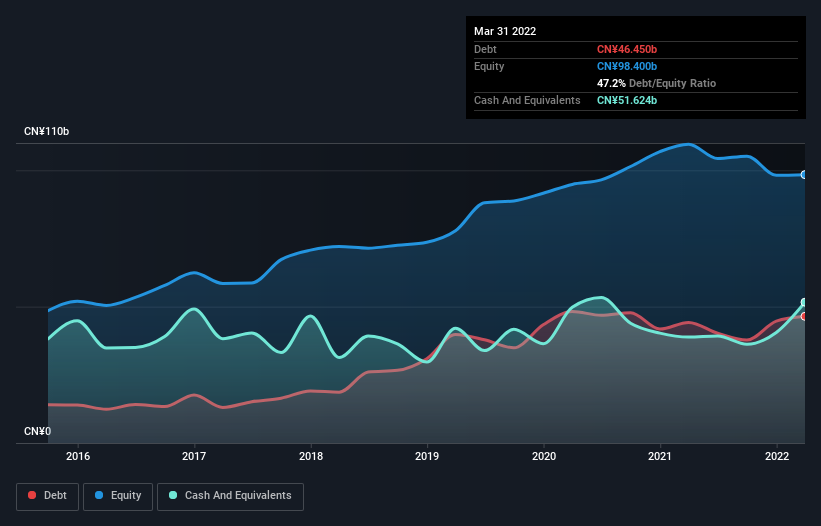
Warren Buffett famously said, 'Volatility is far from synonymous with risk.' When we think about how risky a company is, we always like to look at its use of debt, since debt overload can lead to ruin. We note that Shanghai Electric Group Company Limited (HKG:2727) does have debt on its balance sheet. But the more important question is: how much risk is that debt creating?
When Is Debt A Problem?
Debt and other liabilities become risky for a business when it cannot easily fulfill those obligations, either with free cash flow or by raising capital at an attractive price. If things get really bad, the lenders can take control of the business. While that is not too common, we often do see indebted companies permanently diluting shareholders because lenders force them to raise capital at a distressed price. Of course, the upside of debt is that it often represents cheap capital, especially when it replaces dilution in a company with the ability to reinvest at high rates of return. When we examine debt levels, we first consider both cash and debt levels, together.
Check out our latest analysis for Shanghai Electric Group
What Is Shanghai Electric Group's Debt?
You can click the graphic below for the historical numbers, but it shows that as of March 2022 Shanghai Electric Group had CN¥46.4b of debt, an increase on CN¥44.2b, over one year. But it also has CN¥51.6b in cash to offset that, meaning it has CN¥5.17b net cash.

A Look At Shanghai Electric Group's Liabilities
We can see from the most recent balance sheet that Shanghai Electric Group had liabilities of CN¥161.5b falling due within a year, and liabilities of CN¥33.7b due beyond that. On the other hand, it had cash of CN¥51.6b and CN¥87.6b worth of receivables due within a year. So it has liabilities totalling CN¥56.0b more than its cash and near-term receivables, combined.
This deficit is considerable relative to its market capitalization of CN¥61.2b, so it does suggest shareholders should keep an eye on Shanghai Electric Group's use of debt. Should its lenders demand that it shore up the balance sheet, shareholders would likely face severe dilution. Despite its noteworthy liabilities, Shanghai Electric Group boasts net cash, so it's fair to say it does not have a heavy debt load! The balance sheet is clearly the area to focus on when you are analysing debt. But ultimately the future profitability of the business will decide if Shanghai Electric Group can strengthen its balance sheet over time. So if you want to see what the professionals think, you might find this free report on analyst profit forecasts to be interesting.
Over 12 months, Shanghai Electric Group made a loss at the EBIT level, and saw its revenue drop to CN¥131b, which is a fall of 12%. That's not what we would hope to see.
So How Risky Is Shanghai Electric Group?
By their very nature companies that are losing money are more risky than those with a long history of profitability. And the fact is that over the last twelve months Shanghai Electric Group lost money at the earnings before interest and tax (EBIT) line. And over the same period it saw negative free cash outflow of CN¥10b and booked a CN¥11b accounting loss. With only CN¥5.17b on the balance sheet, it would appear that its going to need to raise capital again soon. Summing up, we're a little skeptical of this one, as it seems fairly risky in the absence of free cashflow. The balance sheet is clearly the area to focus on when you are analysing debt. However, not all investment risk resides within the balance sheet - far from it. These risks can be hard to spot. Every company has them, and we've spotted 1 warning sign for Shanghai Electric Group you should know about.
Of course, if you're the type of investor who prefers buying stocks without the burden of debt, then don't hesitate to discover our exclusive list of net cash growth stocks, today.
New: Manage All Your Stock Portfolios in One Place
We've created the ultimate portfolio companion for stock investors, and it's free.
• Connect an unlimited number of Portfolios and see your total in one currency
• Be alerted to new Warning Signs or Risks via email or mobile
• Track the Fair Value of your stocks
Have feedback on this article? Concerned about the content? Get in touch with us directly. Alternatively, email editorial-team (at) simplywallst.com.
This article by Simply Wall St is general in nature. We provide commentary based on historical data and analyst forecasts only using an unbiased methodology and our articles are not intended to be financial advice. It does not constitute a recommendation to buy or sell any stock, and does not take account of your objectives, or your financial situation. We aim to bring you long-term focused analysis driven by fundamental data. Note that our analysis may not factor in the latest price-sensitive company announcements or qualitative material. Simply Wall St has no position in any stocks mentioned.
About SEHK:2727
Shanghai Electric Group
Provides industrial-grade eco-friendly smart system solutions in Mainland China and internationally.
Undervalued with excellent balance sheet.

